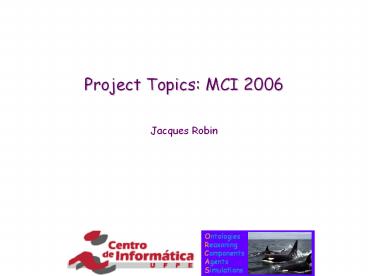Project Topics: MCI 2006 - PowerPoint PPT Presentation
Title:
Project Topics: MCI 2006
Description:
Marcos, Fabr cio, Sandra, Eduardo. ActionPercept interface; Channel; ... Version 2 model UML/OCL of interfaces. Version 2 architecture UML/OCL of components ... – PowerPoint PPT presentation
Number of Views:17
Avg rating:3.0/5.0
Title: Project Topics: MCI 2006
1
Project Topics MCI 2006
- Jacques Robin
2
Simulation Generation Phase
ltlt component gtgt Simulate
ltlt agent gtgt GameEnvironment
ltlt agent gtgt Player
ltlt aspect gtgt EnvironmentReasoningTraceGenerator
ltlt aspect gtgt AgentReasoningTraceGenerator
ltlt component gtgt channel
3
Batch Simulation Analysis Phase
ltlt component gtgt Replay
ltlt interface gtgt TeamAnalysisUserCommands
ltlt component gtgt ReplayGUI
ltlt interface gtgt AgentReasoningTrace
ltlt interface gtgt EnvironmentReasoningTrace
ltlt interface gtgt AgentAnalysisUserCommands
ltlt interface gtgt EnvironmentAnalysisUserCommands
ltlt agent gtgt GameEnvironment
ltlt agent gtgt Player
ltlt aspect gtgt EnvironmentReasoningTraceGenerator
ltlt aspect gtgt AgentReasoningTraceGenerator
4
Batch Simulation Analysis Phase GUI
ltlt component gtgt ReplayGUI
ltlt component gtgt TeamAnalysisController
ltlt component gtgt EnvironmentAnalysisController
ltlt component gtgt AgentAnalysisController
ltlt interface gtgt AgentAnalysisCommandOptions
ltlt interface gtgt TeamAnalysisCommandOptions
ltlt interface gtgt EnvironmentAnalysisCommandOptions
ltlt component gtgt AgentAnalysisView
ltlt component gtgt TeamAnalysisView
ltlt component gtgt EnvironmentAnalysisView
5
Topics
- Topic 1 AgentRicardo, Vitor, Patricia, Uilma
- PerceptAction interface
- AgentAnalysisUserCommands interface
- AgentReasoningTrace interface
- Player agent
- AgentReasoningTraceGenerator aspect.
- Topic 2 EnvironmentMarcos, Fabrício, Sandra,
Eduardo - ActionPercept interface
- Channel
- EnvironmentAnalysisUserCommands interface
- EnvironmentReasoningTrace interface
- Game environment agent
- Simulate component
- EnvironmentReasoningTraceGenerator aspect.
- Topic 3 Agent AnalyzerJoão, Daniel, Priscila,
- AgentAnalysisCommandOptions interface
- EnvironmentAnalysisCommandOptions interface
- AgentAnalysisView component
- AgentAnalysisController component
- EnvironmentAnalysisView component
- EnvironmentAnalysisController component
- Topic 4 Team AnalyzerGustavo, Paulo, Rafael,
Luiz - TeamAnalysisUserCommands interface
- TeamAnalysisCommandOptions interface
- TeamAnalysisView component
- TeamAnalysisController component
- ReplayGUI component
- Replay component.
6
Deliverables Calendar
- 06/07
- Version 1 model UML/OCL of interfaces
- Version 1 architecture UML/OCL of components
- 18/07
- Version 2 model UML/OCL of interfaces
- Version 2 architecture UML/OCL of components
- Version 1 complete specification UML/OCL of
components - Version 1 UML/OCL specification of component
tests - 27/07
- Version 2 complete specification UML/OCL of
components - Version 2 complete specification UML/OCL of
components - Version 1 Java-CHORD implementation and tests of
interfaces and components - ??
- Version 2 Java-CHORD implementation and tests of
interfaces and components
7
Artifacts for UML/OCL Models for each
(sub)-component
- Specification (what does it do?)
- Compulsory
- Class diagram and object diagram with
components interface and ports showing its
connections in the assembly of its containing
component - In that class diagram, classes and associations
defining the type of each operation parameter and
return value in terms of UML2 primitive types and
OCL library types - For each component, interface or class, OCL
classifier invariants - For each attribute, OCL default and derived
values - For each operation from each interface, OCL
pre-conditions - For each query operation from each interface,
OCL body, - For each state altering operation from each
interface, OCL post-conditions - If needed
- Use-case diagram to define at a high-level of
abstraction the services provided by the
component - Protocol state machine in case which interface
operations of the component class can be invoked
is restricted in terms of the components state
in a way that is too complex to express by a
simple pre-condition
8
Artifacts for UML/OCL Models for each
(sub)-component
- Realization (how does it do it?), all compulsory
- Class diagram and object diagram with
components interface and ports showing its
internal assembly in terms of embedded,
finer-grained components, classes and
associations - In that class diagram, classes and associations
defining the type of each operation parameter and
return value in terms of UML2 primitive types and
OCL library types - For each component, interface or class, OCL
classifier invariants - For each attribute, OCL default and derived
values - For each operation from each interface, OCL
pre-condition - For each query operation from each interface
- OCL body under 10 lines, or
- Activity diagrams with OCL expressions as
actions, all under 10 lines - For each state altering operation from each
interface - OCL post-condition under 10 lines or
- Activity diagrams with OCL expressions as
actions, all under 10 lines - Activity diagram with OCL expressions as actions
and objects, to specify each operation body or
post-condition that would require over 10 lines
of OCL
9
Artifacts for UML/OCL Models for each
(sub)-component
- Testing, all compulsory
- Class diagrams and object diagrams with
- Testing interface, allowing its client
components to run tests that access its internal
state - For each server component which services it
requires, tester sub-component to generate tests,
run them by connecting itself to the server
component testing interface and check their
results based on the servers interface operation
pre and post-conditions - In that class diagram
- Classes and associations defining the type of
each operation parameter and return value in
terms of UML2 primitive types and OCL library
types - For each component, interface or class, OCL
classifier invariants - For each attribute, OCL default and derived
values - For each operation from each interface, OCL
pre-condition - For each query operation from each interface,
OCL body, - For each state altering operation from each
interface, OCL post-conditions































